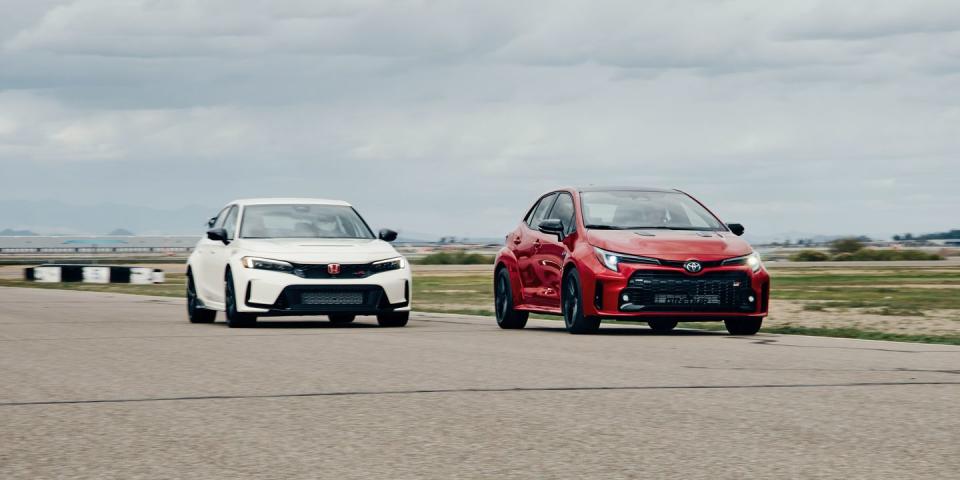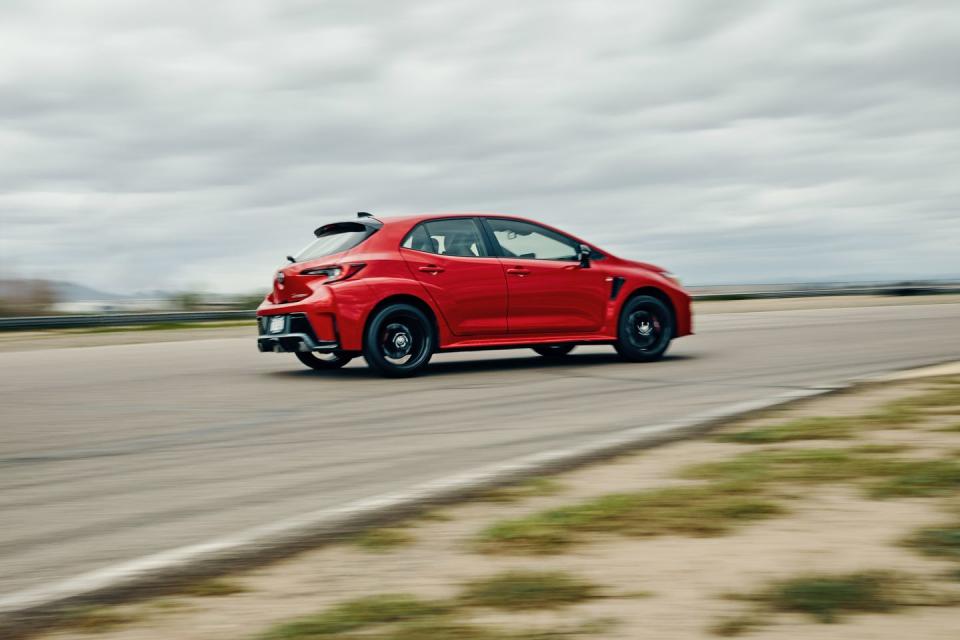Civic Type R vs. GR Corolla: Track Test


On paper, these two cars are nearly identical. Both are designed and built in Japan. Both produce about 300 hp from small turbocharged engines. They both weigh about 3200 pounds and can take a family of four from the house to the race track in comfort. They both cost about $45,000. But they couldn’t be more different to drive. One is playful and a bit rough around the edges; the other is one of the best hot hatches ever to grace a racetrack, simply one of the best performance cars you can buy today for any price.
The GR Corolla Circuit and Civic Type R were always going to be compared directly. They are the hot hatches of the moment, the two newest, most fun kids on the block.
With 300 hp from a 1.6-liter inline-three routed through all four wheels by an advanced all-wheel-drive system and a six-speed manual, the GR Corolla is the raucous rally-bred hatch we needed after Subaru axed the WRX STI.

The new Civic Type R takes every beloved, wonderful thing about the last Type R and makes it better, and then it takes the bad things about the old CTR and remedies those too. It now sends 315 hp to the front wheels—a 9-hp increase from the last-gen car—linked to one of the sweetest six-speed manuals of all time. Both make the frustrating but comfortable Golf R irrelevant, and even make you wonder why anyone would spring for a BMW M3 or Mercedes C63.
While both of these cars belong on the road first, they are also capable track cars. And not just a few parade laps; both of these cars should withstand hours of abuse on track days. That’s why we came here, to Arizona Motorsports Park, to see just how they’d work on a club track, the sort of place where you’ll find the GRC and CTR on weekends hassling Corvettes and Porsches. There aren’t Porsches to hassle today, though there is the constant spectacle of F-35s and F-16s taking off from Luke Air Force Base next to the track.
My first laps are in the GR Corolla, here in Circuit Edition guise. Unlike the Morizo Edition that we had for our last Performance Car of the Year test, the Circuit has back seats, less torque, and taller gearing. It also has Michelin Pilot Sport 4 tires on 18-inch wheels instead of the Morizo’s Pilot Sport Cup 2 rubber. It does still have the carbon roof and the limited slip diffs front and rear, though.

The GRC shows character from the instant it sets off, the 1.6-liter three is obviously turbocharged and it powerband feels meaty and substantial, chocked full of grunt across the tach’s midrange. It’s not the most refined engine in the world. It vibrates and pops and feels like the rally-derived homologation powertrain it is. With every other manufacturer going for a 2.0-liter turbo four, it’s refreshing to have something different that does the job with panache.
That engine mates to an okay six-speed manual, one with a slightly too-heavy shift action even if it can feel direct. I need to be pointed with each shift; this isn’t a gearbox that likes to just slide into gear, instead requiring slower, more deliberate efforts to select the correct gear. Rushing a shift can cause the gearbox synchros to crunch in protest.
My first few laps are spent with the adjustable torque split set at 60:40, and the car just isn’t fun. On power mid-corner, it’ll push. It’s not playful. It feels like a Corolla, and not one of the good ones. Pop the powertrain into its track mode setting and switch the center differential’s torque split to 50:50, and the GR feels suddenly wonderful.

The GR is short and wide, which makes it lively. The brakes are strong, but the short wheelbase means it can be nervous in the braking zone. As I’m pushing deeper and getting more into the brakes on AMP’s plethora of 180-degree corners, I occasionally need to correct on entry, a small dab of opposite lock to keep it in line. Swapping the torque split also transforms the car as it’s putting power down. Get back to power early and it stays neutral, but can be adjusted with a lift off the throttle. It’s not like it’ll drift in that mode, but if I need to tuck the nose in a little more, that slight lift does magic.
There’s one more mode, though, one that promises a lot of fun. That’s the 30:70 torque split. My expectation is that it’ll transform it into an oversteering loon, with big smoky drifts making me look like a hero for the camera. In reality, it feels like any other semi-fake drift mode in hot hatches of this ilk. There is surely more rotation once back to power in a corner, but it’s not of the wild opposite lock counter steering variety. Instead, it makes the rear end feel like it’s on casters, which will ultimately slow down a lap time. That gave me less confidence in the car, since the predictable nature and speed of 50:50 was gone. I’d stick with fifty-fifty in all situations.

 Yahoo Autos
Yahoo Autos 